What is the power of the washing machine motor?
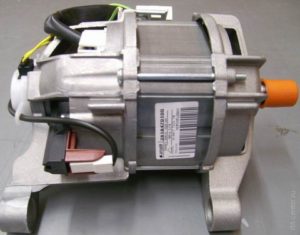 The engine is the “heart” of the washing machine, one of its main components, on which the performance of the equipment depends. The main characteristics of this part are power and number of revolutions per minute. When buying an automatic machine, we rarely pay attention to these parameters. Or maybe in vain? That’s why we decided to talk about how much power the engine has in a washing machine and what it affects.
The engine is the “heart” of the washing machine, one of its main components, on which the performance of the equipment depends. The main characteristics of this part are power and number of revolutions per minute. When buying an automatic machine, we rarely pay attention to these parameters. Or maybe in vain? That’s why we decided to talk about how much power the engine has in a washing machine and what it affects.
Types of engines
The conversion of electrical energy into mechanical energy (rotation of the drum) in a washing machine occurs due to the engine. Engineers have developed three types of engines that are used in automatic washing machines:
- asynchronous motor;
- commutator motor;
- brushless motor.
Asynchronous type motors can be two-phase or three-phase. Modern washing machines manufactured after 2000 do not use two-phase motors. The power of such engines is 180-360 W, the number of revolutions is not high and does not exceed 2800 revolutions per minute during spinning; when washing, the revolutions are about 300. In machines with such an engine, spinning is only 400-600 revolutions per minute, in rare cases 800- 1000.
Asynchronous motors have practically been replaced by brushed motors, which are capable of operating on both alternating and direct current. They are smaller in size and have smooth electronic speed control. The main disadvantage is its design, which includes the presence of brushes; they wear out and become unusable. To restore engine performance, they need to be changed periodically.The power of commutator motors is 380 - 800 W, while the armature rotation speed varies from 11,500 to 15,000 rpm.
For your information! The motor power consumption for washing and spinning is different. The engine manufacturer writes this indicator only on the engine itself; you will not find these numbers in the instructions for the washing machine.

The brushless or inverter motor first appeared in washing machines in 2005, and LG was the first to use it. Its difference is that it is directly connected to the drum without a belt drive. It is more compact than the other two types of engines, simple in design, and has the highest coefficient of efficiency (efficiency). In terms of its power, the inverter motor is not inferior to the previous ones and is capable of spinning the drum during spinning up to 1600-2000 rpm.
Dependence of energy consumption on power
Energy consumption as a whole depends on the power of the electric motor of the washing machine; in other words, how many kilowatts of energy the machine generates per hour. This is what interests the consumer most often, and not the power of the automatic machine’s motor. The energy consumption of the machine consists of: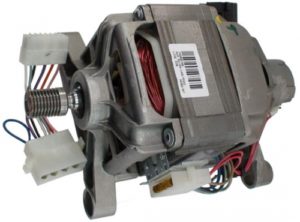
- engine power consumption, during the entire wash it changes, during spinning more, during washing and rinsing less;
- heating element power, which averages from 1.7 to 2.9 kW. Moreover, the higher the water heating temperature, the greater the power consumption;
- the pump power, which is 24-40 W, is quite enough to pump out water;
- total power consumed by light bulbs, control module, sensors, etc. it is approximately 5-10 W.
The power consumption of the washing machine is calculated for the “Cotton” mode, in which the water is heated to 600C, and the machine is loaded to the maximum. According to this indicator, the washing machine is assigned energy efficiency class, denoted by a Latin letter.
The maximum number of revolutions during a spin cycle depends on the power of the washing machine engine.
The more powerful the engine, the more revolutions the drum will make when spinning the laundry. This indicator is reflected in washing machine spin class. Automatic machines rotating at a speed of 1600 rpm are classified as class A. But it is not at all necessary to buy such a machine, because even with a spin of 800-1000 revolutions, the laundry will be well wrung out, without the risk of being torn.
Motor power of different models of washing machines
Washing machines of different brands have different motors, so they have different technical characteristics and different prices. Let's give a few examples.
- MOTOR CESET MCA 52/64-148/AD9 – motor installed on Hotpoin-Ariston and Indesit washing machines, its power is 430 W and 11500 rpm;
- MOTOR CESET MCA38/64-148/CY15 – motor for the Candy, Hoover, Zerovatt washing machine, power is 360 W and 13000 rpm;
- MOTOR CESET CIM2/55-132/WHE1 – electric motor for Whirlpool, Bauknecht washing machines, power 800 W and 17000 rpm;
- WELLING HXGP2I.05 WASHING – motor for the Indesit or Vestel washing machine, spinning power 300 W, washing power 30 W;
- Electronic Control Motor Haier HCD63/39 – motor for Candy and Haier machines, power 220 W and 13,000 rpm;
- HXGP2I Welling Electronic Control Motor – motor for Samsung washing machine, power 300 W.
So, automatic washing machines produced in the 2000s have a brushed or brushless motor. Their power consumption may vary, but for the consumer this does not matter much. It is more important to know how energy efficient a machine is, and this can be determined by the energy consumption class, which modern machines have A or A+.
Interesting:
Reader comments
- Share your opinion - leave a comment


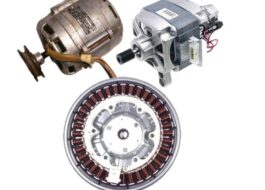

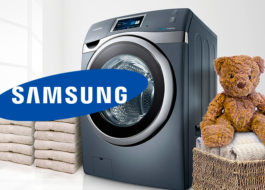

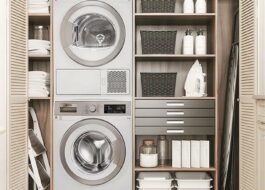














Add a comment